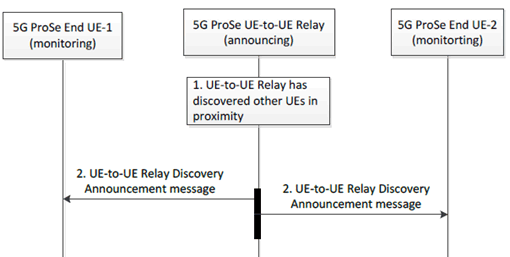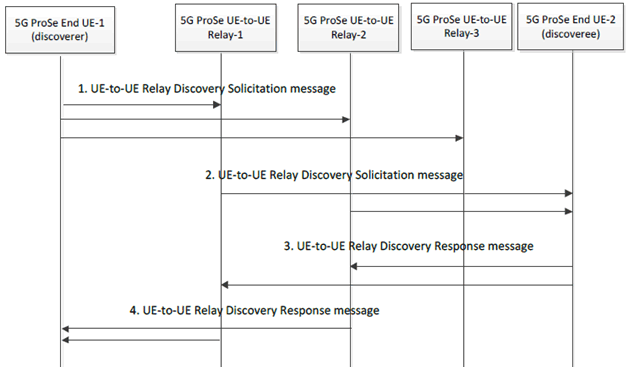Content for TS 23.304 Word version: 19.0.0
1…
4…
4.2.3…
4.2.7…
4.3…
5…
5.1.4…
5.1.5…
5.2…
5.3…
5.4…
5.5…
5.6…
5.7
5.8…
5.9…
6…
6.1.2…
6.2…
6.3…
6.3.2…
6.3.2.3…
6.3.2.4…
6.4…
6.4.3…
6.5…
6.5.2…
6.6…
6.7…
6.7.2…
6.8…
7…
7.2…
6.3.2.4 5G ProSe UE-to-UE Relay Discovery
6.3.2.4.1 General
6.3.2.4.2 Procedure for 5G ProSe UE-to-UE Relay Discovery with Model A
6.3.2.4.3 Procedure for 5G ProSe UE-to-UE Relay Discovery with Model B
6.3.2.4.4 Candidate 5G ProSe UE-to-UE Relay Discovery
6.3.2.4.5 Acquiring Direct discovery set by model A discovery
...
...
6.3.2.4 5G ProSe UE-to-UE Relay Discovery |R18| p. 91
6.3.2.4.1 General p. 91
5G ProSe UE-to-UE Relay Discovery is applicable to both 5G ProSe Layer-3 and Layer-2 UE-to-UE Relay Discovery for public safety use and commercial services. To perform 5G ProSe UE-to-UE Relay Discovery, the 5G ProSe End UE and the 5G ProSe UE-to-UE Relay are pre-configured or provisioned with the related information as described in clause 5.1.
A Relay Service Code (RSC) is used in the 5G ProSe UE-to-UE Relay Discovery, to indicate the connectivity service the 5G ProSe UE-to-UE Relay provides to 5G ProSe End UEs. The RSCs are pre-configured or provisioned on the 5G ProSe UE-to-UE Relay and the 5G ProSe End UE as defined in clause 5.1. The 5G ProSe UE-to-UE Relay and the 5G ProSe End UE are aware of whether a RSC is offering 5G ProSe Layer-2 or Layer-3 UE-to-UE Relay service based on the UE-to-UE Relay Layer indicator as specified in clause 5.1. A 5G ProSe UE-to-UE Relay supporting multiple RSCs advertises the RSCs using multiple discovery messages, with one RSC per discovery message.
6.3.2.4.2 Procedure for 5G ProSe UE-to-UE Relay Discovery with Model A p. 91
Depicted in Figure 6.3.2.4.2-1 is the procedure for 5G ProSe UE-to-UE Discovery with Model A.

Step 1.
The 5G ProSe UE-to-UE Relay has discovered other UEs in proximity and obtains the Direct discovery set from other UEs in proximity per RSC. (e.g. via a previous 5G ProSe UE-to-UE Relay Discovery or via secure PC5 connection between 5G ProSe U2U Relay and 5G ProSe End UE (refer to TS 33.503)).
Step 2.
The 5G ProSe UE-to-UE Relay sends a UE-to-UE Relay Discovery Announcement message. The UE-to-UE Relay Discovery Announcement message contains the Type of Discovery Message, User Info ID of the 5G ProSe UE-to-UE Relay, RSC and Direct discovery set including list of protected user info (i.e. Application Layer ID) received from the 5G ProSe End UEs supporting the RSC. The UE-to-UE Relay Discovery Announcement message is sent using the Source Layer-2 ID and Destination Layer-2 ID as described in clause 5.8.4.
The 5G ProSe UE-to-UE Relay shall only announce user info (i.e. Application Layer ID) of other UEs in proximity that did not include an Announce Prohibited Indication when they were previously discovered.
A 5G ProSe End UE monitors announcement messages from a 5G ProSe UE-to-UE Relay. The 5G ProSe End UEs determine the Destination Layer-2 ID for signalling reception as specified in clause 5.1.
6.3.2.4.3 Procedure for 5G ProSe UE-to-UE Relay Discovery with Model B p. 92
Depicted in Figure 6.3.2.4.3-1 is the procedure for 5G ProSe UE-to-UE Relay Discovery with Model B.

Step 1.
The discoverer 5G ProSe End UE (UE-1) sends a 5G ProSe UE-to-UE Relay Discovery Solicitation message. The 5G ProSe UE-to-UE Relay Discovery Solicitation message contains the Type of Discovery Message, RSC and the Direct Discovery set which includes the protected user info (i.e. Application Layer ID) of the discoverer 5G ProSe End UE (UE-1) and the discoveree 5G ProSe End UE (UE-2). The 5G ProSe UE-to-UE Relay Discovery Solicitation message is sent using the Source Layer-2 ID and Destination Layer-2 ID as described in clause 5.8.4.
A 5G ProSe UE-to-UE Relay determines the Destination Layer-2 ID for signalling reception as specified in clause 5.1.
The discoverer 5G ProSe End UE may include an Announce Prohibited Indication in the UE-to-UE Relay Discovery Solicitation message. If a 5G ProSe UE-to-UE Relay receives a Relay Discovery Solicitation message with an Announce Prohibited Indication it does not consider the 5G ProSe End UE as discovered during this procedure for inclusion in 5G ProSe UE-to-UE Relay Discovery with Model A, see clause 6.3.2.4.2, step 1.
Step 2.
If the RSC contained in the solicitation message matches any of the (pre)configured RSC(s), as specified in clause 5.1.5.1, of a 5G ProSe UE-to-UE Relay, the 5G ProSe UE-to-UE Relay sends a 5G ProSe UE-to-UE Relay Discovery Solicitation message. The 5G ProSe UE-to-UE Relay Discovery Solicitation message contains the Type of Discovery Message, the Direct Discovery set which includes the list of protected user info (i.e. Application Layer ID) of the discoverer 5G ProSe End UE (UE-1) and the discoveree 5G ProSe End UE (UE-2), User Info ID of UE-to-UE Relay, RSC. 5G ProSe UE-to-UE Relay Discovery Solicitation message is sent using the Source Layer-2 ID and Destination Layer-2 ID as described in clause 5.8.4.
A 5G ProSe End UE determines the Destination Layer-2 ID for signalling reception as specified in clause 5.1.
The 5G ProSe UE-to-UE Relay self-selects the Source Layer-2 ID as specified in clause 5.8.4.2.
Step 3.
If the RSC contained in the solicitation message matches any of the (pre)configured RSC(s), as specified in clause 5.1.5.1, of the discoveree 5G ProSe End UE (UE-2), and the discoveree 5G ProSe End UE (UE-2) matches the user info (i.e. Application Layer ID) of the discoveree 5G ProSe End UE (UE-2) contained in the solicitation message, then the discoveree 5G ProSe End UE (UE-2) responds to the 5G ProSe UE-to-UE Relay with a 5G ProSe UE-to-UE Relay Discovery Response message. The 5G ProSe UE-to-UE Relay Discovery Response message contains the Type of Discovery Message, RSC, the Direct Discovery set which includes the protected user info (i.e. Application Layer ID) of the discoverer 5G ProSe End UE (UE-1) and the discoveree 5G ProSe End UE (UE-2). The 5G ProSe UE-to-UE Relay Discovery Response message is sent using the Source Layer-2 ID and Destination Layer-2 ID as described in clause 5.8.4. If the discoveree 5G ProSe End UE (UE-2) receives multiple UE-to-UE Relay Discovery Solicitation messages from different 5G ProSe UE-to-UE Relays with the same RSC and the user info (i.e. Application Layer ID) of the discoveree 5G ProSe End UE (UE-2), it may choose to respond or not to a 5G ProSe UE-to-UE Relay (e.g. based on the PC5 signal strength of each message received).
The discoveree 5G ProSe End UE may include an Announce Prohibited Indication in the UE-to-UE Relay Discovery Response message. If a 5G ProSe UE-to-UE Relay receives a Relay Discovery Response message with an Announce Prohibited Indication it does not consider the 5G ProSe End UE as discovered during this procedure for inclusion in 5G ProSe UE-to-UE Relay Discovery with Model A, see clause 6.3.2.4.2, step 1.
Step 4.
The 5G ProSe UE-to-UE Relay sends a 5G ProSe UE-to-UE Relay Discovery Response message. The 5G ProSe UE-to-UE Relay Discovery Response message contains the Type of Discovery Message, User Info ID of UE-to-UE Relay, RSC, the Direct Discovery set which includes the list of protected user info (i.e. Application Layer ID) of the discoverer 5G ProSe End UE (UE-1) and the discoveree 5G ProSe End UE (UE-2). The 5G ProSe UE-to-UE Relay Discovery Response message is sent using the Source Layer-2 ID and Destination Layer-2 ID as described in clause 5.8.4.
6.3.2.4.4 Candidate 5G ProSe UE-to-UE Relay Discovery p. 93
This procedure for candidate 5G ProSe UE-to-UE Relay Discovery to support the negotiated Relay reselection as described in clause 6.7.4 when the discoverer End UE discovers a candidate 5G ProSe UE-to-UE Relay.
The procedure for 5G ProSe UE-to-UE Relay Discovery with Model B (see clause 6.3.2.4.3) is used with the following differences:
- Step 1: In the 5G ProSe UE-to-UE Relay Discovery Solicitation message the RSC and the User Info ID of a candidate 5G ProSe UE-to-UE Relay are included in the UE-to-UE Relay Discovery set and the Direct Discovery set is not included. If the 5G ProSe End UE receives the Layer-2 ID of the candidate 5G ProSe UE-to-UE Relay in a Link Modification Request message, it may set the Layer-2 ID of the candidate 5G ProSe UE-to-UE Relay as the Destination Layer-2 ID.
- Step 2 and step 3 are skipped because Direct Discovery set is absent, and the User Info ID of the candidate 5G ProSe UE-to-UE Relay in the received 5G ProSe UE-to-UE Relay Discovery Solicitation message matches that of the 5G ProSe UE-to-UE Relay.
- Step 4: If a 5G ProSe UE-to-UE Relay matches the User Info ID of a candidate 5G ProSe UE-to-UE Relay received in the 5G ProSe UE-to-UE Relay Discovery Solicitation then it sends the 5G ProSe UE-to-UE Relay Discovery Response (with the RSC received in step 1) and does not include the Direct Discovery set.
6.3.2.4.5 Acquiring Direct discovery set by model A discovery p. 93
The 5G ProSe UE-to-UE Relay may monitor Announcement messages from the 5G ProSe End UEs.
When receiving an Announcement message from a 5G ProSe End UE, the 5G ProSe UE-to-UE Relay may include the received protected user info (i.e. Application Layer ID) in the UE-to-UE Relay Discovery Announcement message as specified in clause 6.3.2.4.2.